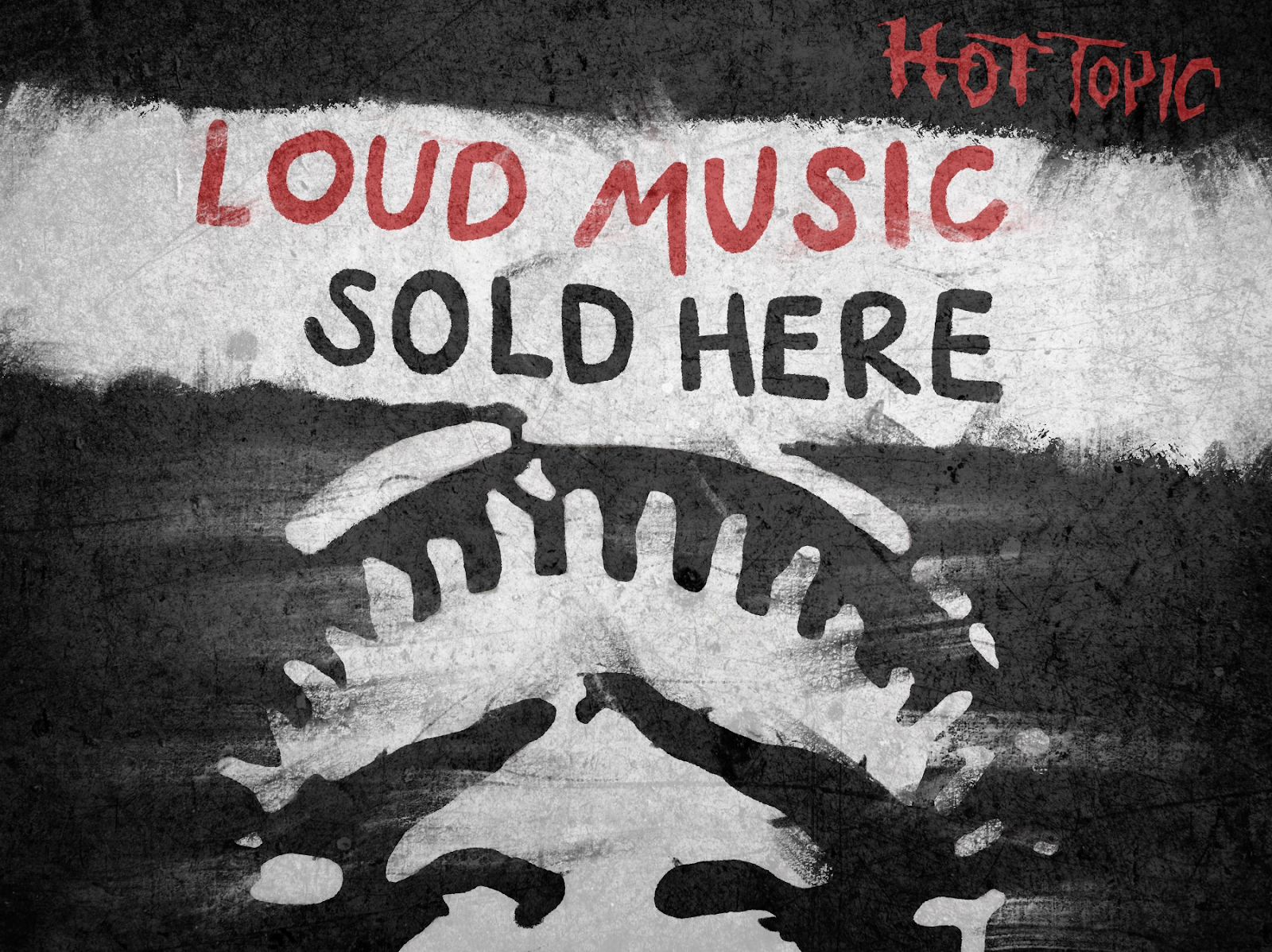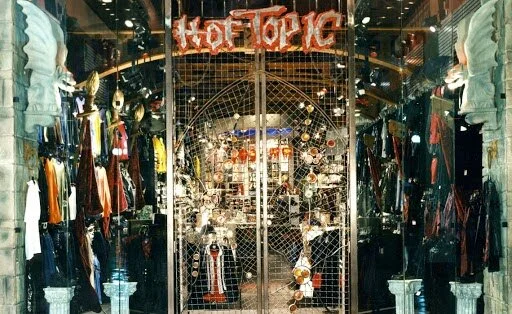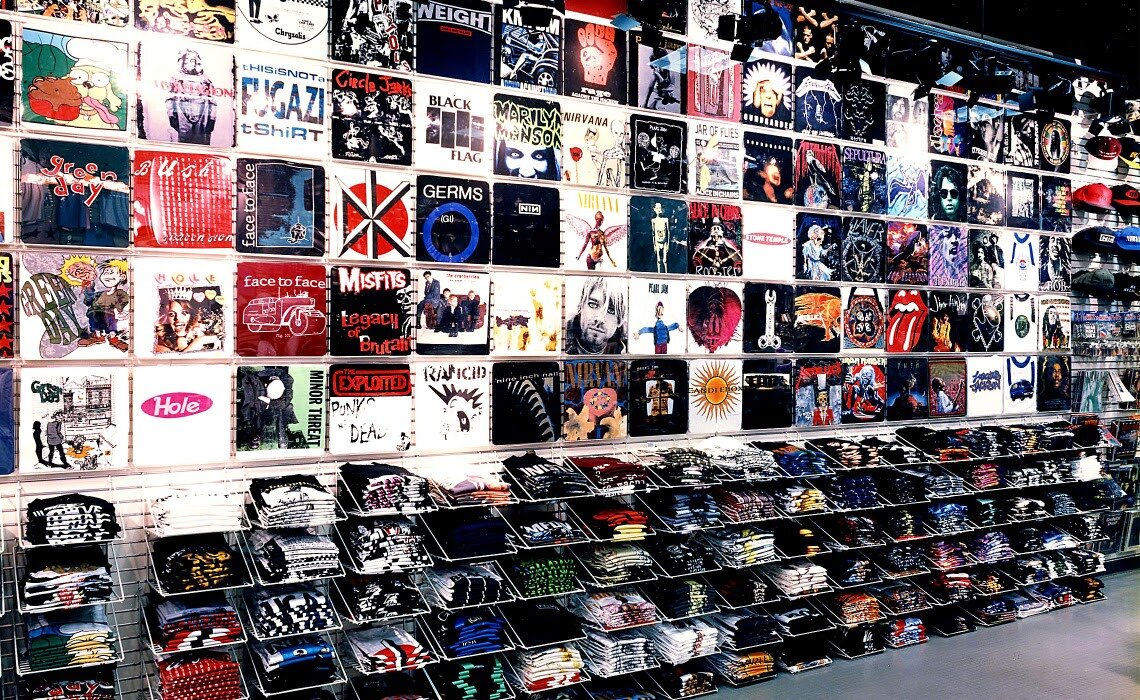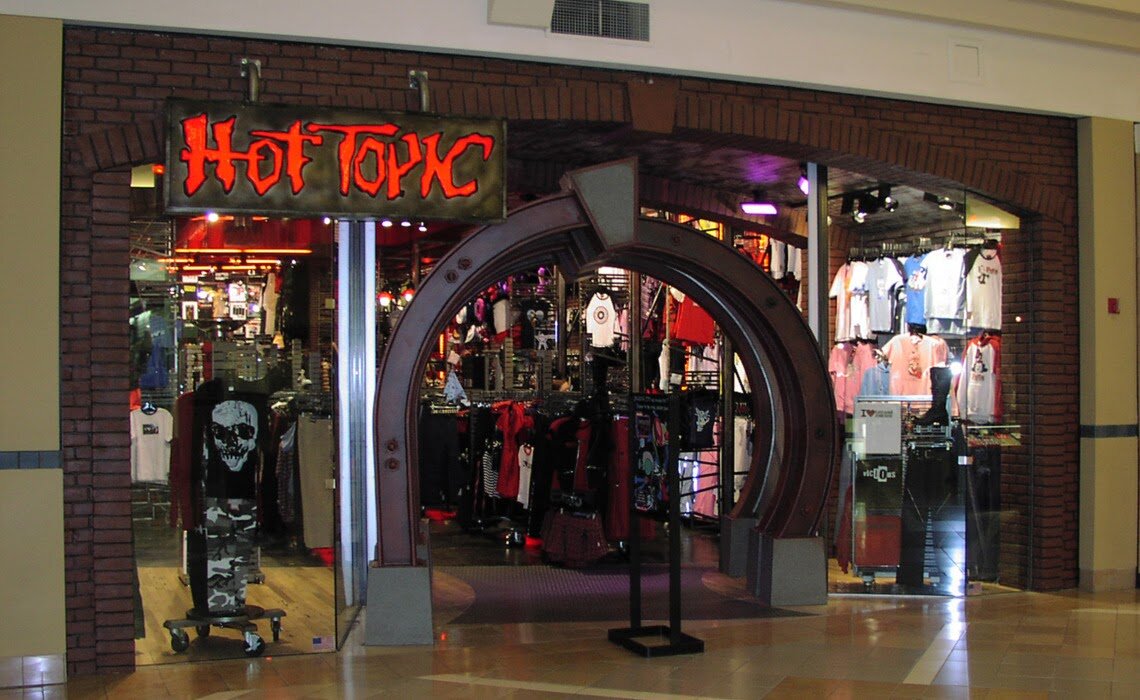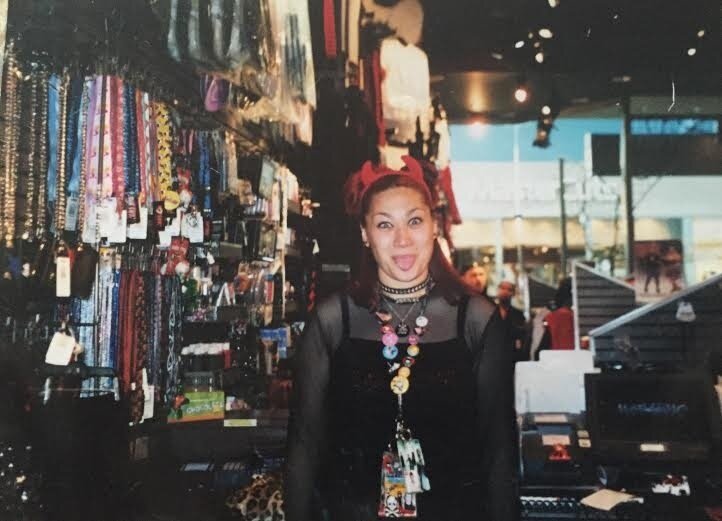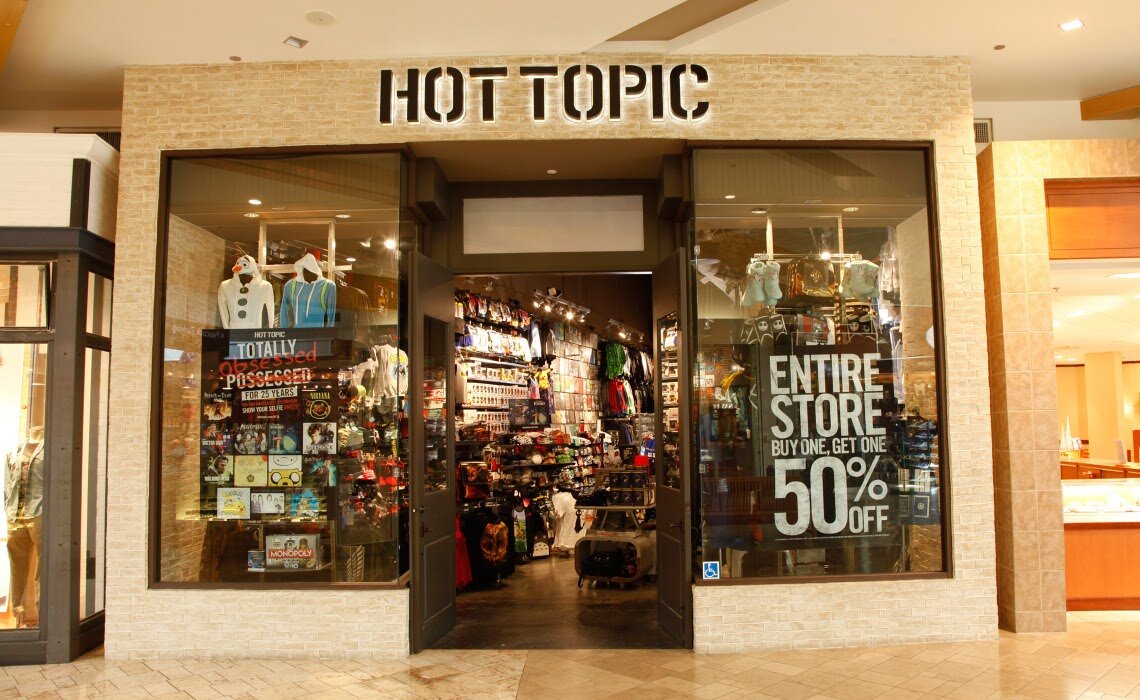The Style of Sound: The Hot Topic Evolution of Rockers and Emos
Hot Topic has been at the root of subcultural style for decades, and fittingly, is one of the last retail chains still flourishing as malls across the world die off.
From the stage to the runway, The Style of Sound is a series that explores the intricate relationships forged between your favorite artists and their iconic fashion statements.
Written by Miranda Robertson
Illustrated by Haley Wood
During the heyday of MTV, bands like Siouxsie and the Banshees, Danzig, and Sister of Mercy fronted a soar in gothic rock representation. As goth rock and other rock genres continued to gain a following, so did the styles sported by those artists. To obtain the fashion, punk and goth fans first relied heavily on DIY accessories and distressed shirts. But as economic situations improved in the late ‘80s, American shopping malls flourished, and an opportunity came to capitalize on this untapped market. Enter Hot Topic, a store that started out as the essential mall hub for all punk and gothic accessories such as body jewelry, chains, and spikes, but quickly became the go-to spot for music and pop culture merchandise. Its way of helping young fans feel free to express their interests and identities combined with easily accessible stores and reasonable retail prices allowed Hot Topic to become the fundamental shop for the music and musicians it promoted.
Photo courtesy of Hot Topic
Embodying goth in the ‘80s meant setting yourself aside from societal norms and embracing the darker side of life just as those in the ‘70s post-punk scene did. To demonstrate their acts of rebellion, goths put on edgy, sometimes racy clothing — not caring what anyone thought of the stand-out look. The genre’s style consisted of all-black attire: including jet black, teased hair, and dark eyeshadow with black or red lipstick to match. Bands like Alien Sex Fiend and Specimen incorporated punk fashion statements with fishnet material, clunky shoes, and white face paint. Goth’s style also took inspiration from romantic Victorian-era fashion by way of lace corsets and gloves. Catering to the wearers of these trends, Hot Topic’s original store was a stand out among the brightly lit mall shops around it. “The Loudest Store in the Mall” strived to create a place for all types of music and fashion culture previously misunderstood by most retailers.
Photo courtesy of Hot Topic
Hot Topic’s first location opened in November 1989 in Montclair Plaza, California. The original store performed well and received a great amount of praise from the subcultures it catered to. After their initial success, the owners of Hot Topic decided to expand their business, opening up several new stores in the ‘90s, and selling new merchandise like the infamous “band tee wall” that the store is still so well-known for. This growth allowed Hot Topic to become the first main retail chain to make these styles and trends available nationwide. The expansion made accessories and apparel accessible to fans of genres that would be popularized in the coming years, such as grunge, nu-metal, and emo. Through its near 33-year reign, Hot Topic’s selections became very diverse and the store even influenced and introduced its shoppers to other music genres.
The inside of the new stores that popped up across the United States evoked the imagery of a rock gig with dim lights and shelves designed to look like guitar cases. The store’s redesigned logo became notorious for the scratchy, gothic font that bands like The Cramps and later Korn also used. And to create the perfect setting for their patrons, the store kept a playlist of the decade’s hottest rock subgenres blasting through the wall speakers at all times. Just like rock fans who wanted to imitate the musicians they loved, Hot Topic’s design was inspired by musicians and their fans. Of course, with each decade and new era of music, new fashion trends popped up, too.
Photo courtesy of Hot Topic
The ’90s saw the rise of grunge and the beginning of nu-metal, as musicians such as Nirvana, Pearl Jam, and later on, Linkin Park and Kid Rock dominated the airwaves. Grunge fashion drew on its punk rock, lo-fi roots with lighter colors and an emphasis on the chill, comfortable ‘stoner’ look. Imitating the late Kurt Cobain, members of the grunge scene often had a heavy collection of flannels, baggy jeans, and beanies. On the other side of ‘90s subculture, nu-metal drew inspiration from hip-hop and skate culture. Typical accessories in nu-metal fashion were chain wallets, phat pants, and Adidas tracksuits, taking colors back to the classic black. Joining spikes and studs on the walls of Hot Topic were almost every chain accessory one could think of. At a later time, the store was sure to make its mark with these two subgenres promoting festivals such as “Ozzfest” in 2004 and the “Sounds of the Underground” tour from 2005 to 2007.
As nu-metal dissipated in the early 2000s, a new genre made its way to the forefront of subcultural style. Bands like My Chemical Romance, The Used, and Fall Out Boy carried emo to the top of the charts. Hot Topic continued to promote the musicians that brought its clientele with their sponsorship of the “Taste of Chaos” tour in 2008. These bands incorporated black, bloodstained attire into their style, along with heavy use of eyeliner and eyeshadow, and greasy black hair. My Chemical Romance’s lead singer, Gerard Way, even mentioned that after he graduated, Hot Topic was the only place that would employ him. In an interview with Hot Topic, Way talked about how he “worked at the Hot Topic (in Willowbrook Mall in New Jersey). Coming out of art school… money was getting tight and (he) applied to Hot Topic.” He also mentioned he always “remembers putting shirts on the tee wall” and that he still uses the Hot Topic “clipboard folding” technique to this day.
Zeena Koda, a former Hot Topic store manager in the early 2000s (Photo courtesy of Zeena Koda from Vice)
The emo subculture took original goth trends and added a bit of ‘cutesy’ to them. The result was the popularity of shirts featuring sad doll caricatures and skulls with bows. Other emo clothing was usually dark skinny jeans with distressed rips, Converse sneakers, and of course, the beloved emo band tee. A subculture that grew out of emo dubbed “scene” used more neon colors and cute patterns in its clothing, emphasizing vanity and paying extra attention to big, messy hair with pink and green feathers or ‘coontail’ extensions. Pop culture references were also imputed into scene fashion and music. Characters like Nickelodeon’s “Invader Zim” and Lisa Frank merchandise became especially popular among self-proclaimed “scene kids.”
The current Hot Topic in your local mall is a bit different from the golden era stores that featured a dark tunnel entrance. To keep up with changing times and the decline in mall go-ers, Hot Topic worked deals with many pop culture brands and television shows to widen its stock for more consumers. The average Hot Topic store carries sci-fi and anime merchandise along with pop and K-pop memorabilia — a whole new playing field compared to where it all began. The retailers also have a well-run website to keep up with the new and progressive world of online shopping.
Today’s Hot Topic storefront in all its glory (Photo courtesy of Hot Topic)
Some of the original looks from decades past have regained popularity today. People still search for the iconic Tripp NYC tartan mini skirts, striped fingerless gloves, and the studded belts that are now considered vintage pieces. Who knows, with the rise of Y2k fashion and music back in trend, we could be seeing some resurgence of the old Hot Topic in the near future. In terms of the stores’ design and aesthetics, there’s been a huge shift from the original daunting black cave in the mall we knew and loved. But the original goth rock beginnings will always go on in rock genre history.
Music and self-expression through fashion complement each other. Being able to define yourself through your own aesthetics, style, and interests is something that’s imperative to one’s identity. Hot Topic’s embrace of these musical subgenres — more like lifestyles — in its fashion selection through time has made people on the fringes of mainstream culture feel some sense of belonging.

